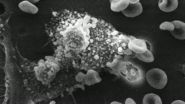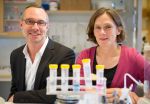(Press-News.org) CAMBRIDGE, Mass--Concrete is the world's most-used construction material, and a leading contributor to global warming, producing as much as one-tenth of industry-generated greenhouse-gas emissions. Now a new study suggests a way in which those emissions could be reduced by more than half — and the result would be a stronger, more durable material.
The findings come from the most detailed molecular analysis yet of the complex structure of concrete, which is a mixture of sand, gravel, water, and cement. Cement is made by cooking calcium-rich material, usually limestone, with silica-rich material — typically clay — at temperatures of 1,500 degrees Celsius, yielding a hard mass called "clinker." This is then ground up into a powder. The decarbonation of limestone, and the heating of cement, are responsible for most of the material's greenhouse-gas output.
The new analysis suggests that reducing the ratio of calcium to silicate would not only cut those emissions, but would actually produce better, stronger concrete. These findings are described in the journal Nature Communications by MIT senior research scientist Roland Pellenq; professors Krystyn Van Vliet, Franz-Josef Ulm, Sidney Yip, and Markus Buehler; and eight co-authors at MIT and at CNRS in Marseille, France.
"Cement is the most-used material on the planet," Pellenq says, noting that its present usage is estimated to be three times that of steel. "There's no other solution to sheltering mankind in a durable way — turning liquid into stone in 10 hours, easily, at room temperature. That's the magic of cement."
In conventional cements, Pellenq explains, the calcium-to-silica ratio ranges anywhere from about 1.2 to 2.2, with 1.7 accepted as the standard. But the resulting molecular structures have never been compared in detail. Pellenq and his colleagues built a database of all these chemical formulations, finding that the optimum mixture was not the one typically used today, but rather a ratio of about 1.5.
As the ratio varies, he says, the molecular structure of the hardened material progresses from a tightly ordered crystalline structure to a disordered glassy structure. They found the ratio of 1.5 parts calcium for every one part silica to be "a magical ratio," Pellenq says, because at that point the material can achieve "two times the resistance of normal cement, in mechanical resistance to fracture, with some molecular-scale design."
The findings, Pellenq adds, were "validated against a large body of experimental data." Since emissions related to concrete production are estimated to represent 5 to 10 percent of industrial greenhouse-gas emissions, he says, "any reduction in calcium content in the cement mix will have an impact on the CO2." In fact, he says, the reduction in carbon emissions could be as much as 60 percent.
In addition to the overall improvement in mechanical strength, Pellenq says, because the material would be more glassy and less crystalline, there would be "no residual stresses in the material, so it would be more fracture-resistant."
The work is the culmination of five years of research by a collaborative team from MIT and CNRS, where Pellenq is research director. The two institutions have a joint laboratory at MIT called the Multi-Scale Materials Science for Energy and Environment, run by Pellenq and Ulm, who is director of MIT's Concrete Sustainability Hub, and hosted by the MIT Energy Initiative.
Because of its improved resistance to mechanical stress, Pellenq says the revised formulation could be of particular interest to the oil and gas industries, where cement around well casings is crucial to preventing leakage and blowouts. "More resistant cement certainly is something they would consider," Pellenq says.
So far, the work has remained at the molecular level of analysis, he says. "Next, we have to make sure these nanoscale properties translate to the mesoscale" — that is, to the engineering scale of applications for infrastructure, housing, and other uses.
INFORMATION:
The Concrete Sustainability Hub is supported by the Portland Cement Association and the Ready Mixed Concrete Research and Education Foundation.
How to make stronger, 'greener' cement
Analysis of material's molecular structure leads to a new formula that could cut greenhouse-gas emissions
2014-09-25
ELSE PRESS RELEASES FROM THIS DATE:
BUSM researchers find NAS treatment needs standardization
2014-09-25
(Boston) – When it comes to treating infants with neonatal abstinence syndrome (NAS), researchers from Boston University School of Medicine (BUSM) believe the care for these infants should be consistent and objective, with standardized assessment tools and evidence to back up pharmacologic and nonpharmacologic treatment choices.
The review paper, which is published online in Addiction Science & Clinical Practice, highlights the need for more research in this field to optimize care for both infants and their mothers.
NAS is a collection of signs and symptoms infants ...
Fecal microbiota transplantation recommended for treatment of C. difficile
2014-09-25
(Vienna, October 26, 2014) The transplantation of faecal microbiota from a healthy donor has been shown in recent clinical studies to be a safe and highly effective treatment for recurrent Clostridium difficile (C. difficile) infection and is now recommended in European treatment guidelines.1,2 Faecal microbiota transplantation (FMT) has emerged as a revolutionary, potentially life-saving treatment for this common, difficult-to-treat infection, and is showing promise in the management of other microbiota-related conditions.3,4
Presenting at the 22nd United European Gastroenterology ...
In the face of uncertainty, the brain chooses randomness as the best strategy
2014-09-25
AUDIO:
Editor Karen Carniol interviews Dr. Alla Karpova on her latest Cell paper.
Click here for more information.
Past experience is usually a reliable guide for making decisions, but in unpredictable and challenging situations, it might make more sense to take risks. A study published by Cell Press September 25th in the journal Cell shows that, in competitive situations, rats abandon their normal tactic of using past experience to make decisions and instead make random choices ...
How the brain gains control over Tourette syndrome
2014-09-25
Tourette syndrome is a developmental disorder characterized by involuntary, repetitive, and stereotyped movements or utterances. Now researchers reporting in the Cell Press journal Current Biology on September 25 have new evidence to explain how those with Tourette syndrome in childhood often manage to gain control over those tics. In individuals with the condition, a portion of the brain involved in planning and executing movements shows an unusual increase compared to the average brain in the production of a primary inhibitory neurotransmitter known as GABA.
The paradoxical ...
Modified vitamin D shows promise as treatment for pancreatic cancer
2014-09-25
VIDEO:
Salk scientists find that a vitamin D-derivative makes tumors vulnerable to chemotherapy.
Click here for more information.
LA JOLLA—A synthetic derivative of vitamin D was found by Salk Institute researchers to collapse the barrier of cells shielding pancreatic tumors, making this seemingly impenetrable cancer much more susceptible to therapeutic drugs.
The discovery has led to human trials for pancreatic cancer, even in advance of its publication today in the journal ...
How physical exercise protects the brain from stress-induced depression
2014-09-25
Physical exercise has many beneficial effects on human health, including the protection from stress-induced depression. However, until now the mechanisms that mediate this protective effect have been unknown. In a new study in mice, researchers at Karolinska Institutet in Sweden show that exercise training induces changes in skeletal muscle that can purge the blood of a substance that accumulates during stress, and is harmful to the brain. The study is being published in the prestigious journal Cell.
"In neurobiological terms, we actually still don't know what depression ...
Brain chemical potential new hope in controlling Tourette Syndrome tics
2014-09-25
A chemical in the brain plays a vital role in controlling the involuntary movements and vocal tics associated with Tourette Syndrome (TS), a new study has shown.
The research by psychologists at The University of Nottingham, published in the latest edition of the journal Current Biology, could offer a potential new target for the development of more effective treatments to suppress these unwanted symptoms.
The study, led by PhD student Amelia Draper under the supervision of Professor Stephen Jackson, found that higher levels of a neurochemical called GABA in a part ...
Super enhancers in the inflamed endothelium
2014-09-25
Boston, MA – Normally, the lining of blood vessels, or endothelium, when at rest, acts like Teflon, ignoring the many cells and other factors rushing by in the bloodstream. In response to inflammatory signals, as well as other stimuli, endothelial cells change suddenly and dramatically—sending out beacons to attract inflammatory cells, changing their surface so those cells can stick and enter tissues, and initiating a complex cascade of responses essential to fighting infection and dealing with injury. Unfortunately, these same endothelial responses also promote atherosclerosis, ...
Novel compound prevents metastasis of multiple myeloma in mouse studies
2014-09-25
BOSTON –– In an advance against the problem of cancer metastasis, Dana-Farber Cancer Institute scientists have shown that a specially developed compound can impede multiple myeloma from spreading to the bones in mice. The findings, published in the Sept. 25 issue of Cell Reports, suggest the technique can protect human patients, as well, from one of the most deadly aspects of cancer.
The research involves a new approach to the challenge of cancer metastasis, the process by which tumors spread to and colonize distant parts of the body. Whereas research has traditionally ...
Dinosaur family tree gives fresh insight into rapid rise of birds
2014-09-25
The most comprehensive family tree of meat-eating dinosaurs ever created is enabling scientists to discover key details of how birds evolved from them.
The study has shown that the familiar anatomical features of birds – such as feathers, wings and wishbones – all first evolved piecemeal in their dinosaur ancestors over tens of millions of years.
However, once a fully functioning bird body shape was complete, an evolutionary explosion began, causing a rapid increase in the rate at which birds evolved. This led eventually to the thousands of avian species that we know ...
LAST 30 PRESS RELEASES:
Why nail-biting, procrastination and other self-sabotaging behaviors are rooted in survival instincts
Regional variations in mechanical properties of porcine leptomeninges
Artificial empathy in therapy and healthcare: advancements in interpersonal interaction technologies
Why some brains switch gears more efficiently than others
UVA’s Jundong Li wins ICDM’S 2025 Tao Li Award for data mining, machine learning
UVA’s low-power, high-performance computer power player Mircea Stan earns National Academy of Inventors fellowship
Not playing by the rules: USU researcher explores filamentous algae dynamics in rivers
Do our body clocks influence our risk of dementia?
Anthropologists offer new evidence of bipedalism in long-debated fossil discovery
Safer receipt paper from wood
Dosage-sensitive genes suggest no whole-genome duplications in ancestral angiosperm
First ancient human herpesvirus genomes document their deep history with humans
Why Some Bacteria Survive Antibiotics and How to Stop Them - New study reveals that bacteria can survive antibiotic treatment through two fundamentally different “shutdown modes”
UCLA study links scar healing to dangerous placenta condition
CHANGE-seq-BE finds off-target changes in the genome from base editors
The Journal of Nuclear Medicine Ahead-of-Print Tip Sheet: January 2, 2026
Delayed or absent first dose of measles, mumps, and rubella vaccination
Trends in US preterm birth rates by household income and race and ethnicity
Study identifies potential biomarker linked to progression and brain inflammation in multiple sclerosis
Many mothers in Norway do not show up for postnatal check-ups
Researchers want to find out why quick clay is so unstable
Superradiant spins show teamwork at the quantum scale
Cleveland Clinic Research links tumor bacteria to immunotherapy resistance in head and neck cancer
First Editorial of 2026: Resisting AI slop
Joint ground- and space-based observations reveal Saturn-mass rogue planet
Inheritable genetic variant offers protection against blood cancer risk and progression
Pigs settled Pacific islands alongside early human voyagers
A Coral reef’s daily pulse reshapes microbes in surrounding waters
EAST Tokamak experiments exceed plasma density limit, offering new approach to fusion ignition
Groundbreaking discovery reveals Africa’s oldest cremation pyre and complex ritual practices
[Press-News.org] How to make stronger, 'greener' cementAnalysis of material's molecular structure leads to a new formula that could cut greenhouse-gas emissions


